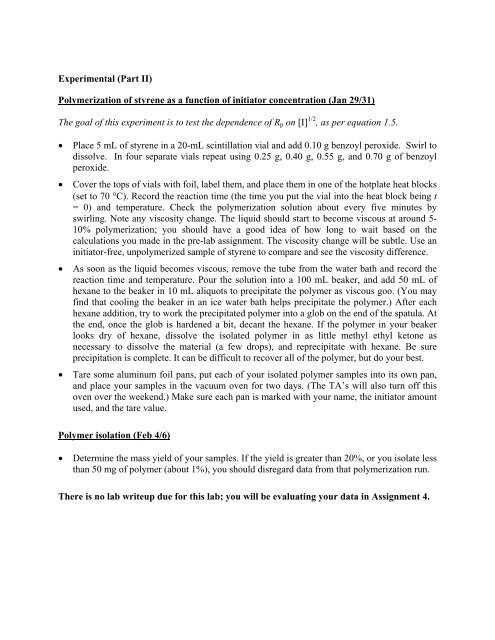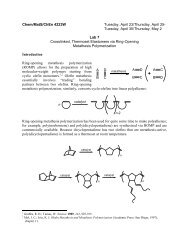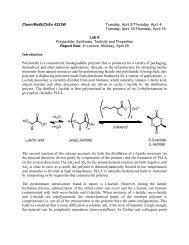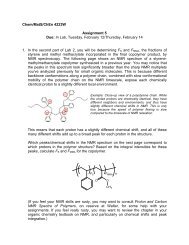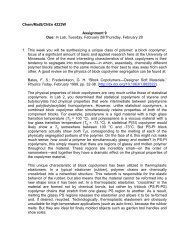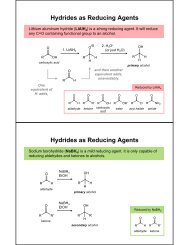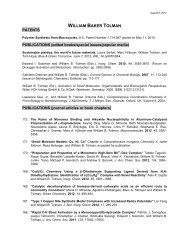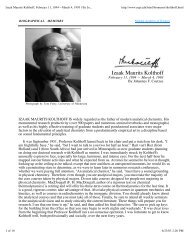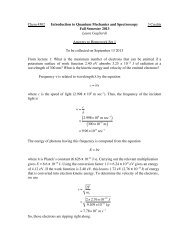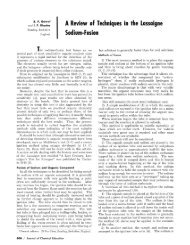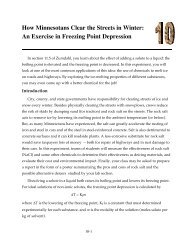Chem/MatS/ChEn 4223W Tuesday, January 22/Thursday, January ...
Chem/MatS/ChEn 4223W Tuesday, January 22/Thursday, January ...
Chem/MatS/ChEn 4223W Tuesday, January 22/Thursday, January ...
You also want an ePaper? Increase the reach of your titles
YUMPU automatically turns print PDFs into web optimized ePapers that Google loves.
Experimental (Part II)Polymerization of styrene as a function of initiator concentration (Jan 29/31)The goal of this experiment is to test the dependence of R p on [I] 1/2 , as per equation 1.5.Place 5 mL of styrene in a 20-mL scintillation vial and add 0.10 g benzoyl peroxide. Swirl todissolve. In four separate vials repeat using 0.25 g, 0.40 g, 0.55 g, and 0.70 g of benzoylperoxide.Cover the tops of vials with foil, label them, and place them in one of the hotplate heat blocks(set to 70 C). Record the reaction time (the time you put the vial into the heat block being t= 0) and temperature. Check the polymerization solution about every five minutes byswirling. Note any viscosity change. The liquid should start to become viscous at around 5-10% polymerization; you should have a good idea of how long to wait based on thecalculations you made in the pre-lab assignment. The viscosity change will be subtle. Use aninitiator-free, unpolymerized sample of styrene to compare and see the viscosity difference.As soon as the liquid becomes viscous, remove the tube from the water bath and record thereaction time and temperature. Pour the solution into a 100 mL beaker, and add 50 mL ofhexane to the beaker in 10 mL aliquots to precipitate the polymer as viscous goo. (You mayfind that cooling the beaker in an ice water bath helps precipitate the polymer.) After eachhexane addition, try to work the precipitated polymer into a glob on the end of the spatula. Atthe end, once the glob is hardened a bit, decant the hexane. If the polymer in your beakerlooks dry of hexane, dissolve the isolated polymer in as little methyl ethyl ketone asnecessary to dissolve the material (a few drops), and reprecipitate with hexane. Be sureprecipitation is complete. It can be difficult to recover all of the polymer, but do your best.Tare some aluminum foil pans, put each of your isolated polymer samples into its own pan,and place your samples in the vacuum oven for two days. (The TA’s will also turn off thisoven over the weekend.) Make sure each pan is marked with your name, the initiator amountused, and the tare value.Polymer isolation (Feb 4/6)Determine the mass yield of your samples. If the yield is greater than 20%, or you isolate lessthan 50 mg of polymer (about 1%), you should disregard data from that polymerization run.There is no lab writeup due for this lab; you will be evaluating your data in Assignment 4.


